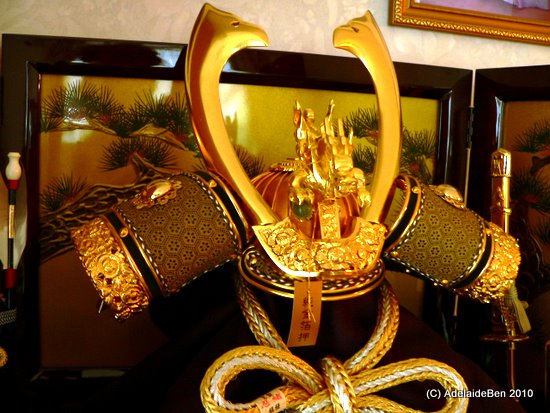5th May, 2008 - Well this is a bit of a strange post, as it's first and foremost a post about our trip back in 2008 - but the 7th of November... today... is also T-chan's father's (otousan) birthday.
As I said in the previous post, Golden Week is a strange conjunction of public holidays that give the Japanese at least the illusion of a week's worth of holidays... and one of the important holidays in that week is the 5th of May, the Boy's Festival... tango no sekku. Actually this festival started out as a rice-planting festival, and as the main protagonists of this activity were in fact women, the festival strangely enough was more associated with a girls festival...Now, how did this become to be a boys festival I hear you ask? For this I am using: Japan - How we breathe & How our Hearts beat.... which is not a bad resource on the why's and how's of Japanese tradition.
Now the 5th month was associated with the horse (uma) which was phonetically similar to the Chinese for 5, the 5th of May was seen as being particularly auspicious. The day was established as an Imperial tradition when it transferred across the seas from it's source in China. This eventually underwent a metamorphosis into something that resembled todays tango no sekku. The most obvious display that occurs these days is the flying of koinobori (or carp pennants or kites)... although we weren't going to display ours until we got back to Adelaide. I'll show more later on... or you can pop over to my other blog that shows an example.
In the end, we had a yummy dinner waiting for us... with special red rice (sekihan) espcially for L-kun. This sticky rice is cooked with azuki beans, that give it the distinctive red colouring. It is traditionally given at a time of celebration and happiness. L-kun's first tango no sekku was such a time. It's a shame that of the food that okaasan had prepared tonight, L-kun was too young to eat most of it.
As I said in the previous post, Golden Week is a strange conjunction of public holidays that give the Japanese at least the illusion of a week's worth of holidays... and one of the important holidays in that week is the 5th of May, the Boy's Festival... tango no sekku. Actually this festival started out as a rice-planting festival, and as the main protagonists of this activity were in fact women, the festival strangely enough was more associated with a girls festival...Now, how did this become to be a boys festival I hear you ask? For this I am using: Japan - How we breathe & How our Hearts beat.... which is not a bad resource on the why's and how's of Japanese tradition.
Now the 5th month was associated with the horse (uma) which was phonetically similar to the Chinese for 5, the 5th of May was seen as being particularly auspicious. The day was established as an Imperial tradition when it transferred across the seas from it's source in China. This eventually underwent a metamorphosis into something that resembled todays tango no sekku. The most obvious display that occurs these days is the flying of koinobori (or carp pennants or kites)... although we weren't going to display ours until we got back to Adelaide. I'll show more later on... or you can pop over to my other blog that shows an example.
In the end, we had a yummy dinner waiting for us... with special red rice (sekihan) espcially for L-kun. This sticky rice is cooked with azuki beans, that give it the distinctive red colouring. It is traditionally given at a time of celebration and happiness. L-kun's first tango no sekku was such a time. It's a shame that of the food that okaasan had prepared tonight, L-kun was too young to eat most of it.
And it wouldn't be an occasion without a cake... Japanese love their occasions, and they celebrate occasions with beautifully decorated cakes. This one is fairly modest in comparison to some that you see in the shops... but it was delicious. Japanese cakes definitely aren't as rich as the ones we have in Australia, but they're much more tastier (IMHO). As I said however, L-kun was just a little to young to enjoy cake anyhow. Mum and Dad would have to help out. The message at the top, kodomonohi, means Children's Day. It is somewhat interesting to me that Children's Day (a public holiday) is associated solely with the Boys Festival. Girls have their own day, hinamatsuri, that is celebrated on March 3.
 |
| Children's Day Cake. |
And a special gift for L-kun from otousan and okaasan... L-kun's very own kabuto, or samurai's armoured helmet... Now the kabuto hark back the origins of the boy's festival when samurai would display their armour out the front of their houses. The samurai helmet is now synonymous with the tradition of the boys festival. Together with the koinobori, they are signs of a strong boy. It's a special gift for any boy, and one that goes back into the centuries of Japanese tradition.
 |
| Otousan, L-kun, Okaasan stand in front of kabuto. |
So, on otousan's birthday, we thank you very much... from a long way away. O'tanjoubi omedetou gozaimasu! Happy Birthday!


No comments:
Post a Comment